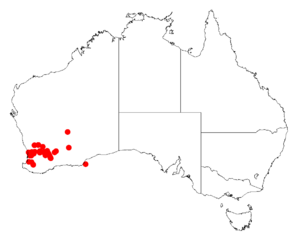Acacia ephedroides facts for kids
Quick facts for kids Acacia ephedroides |
|
|---|---|
| Scientific classification | |
| Genus: |
Acacia
|
| Species: |
ephedroides
|
 |
|
| Occurrence data from AVH | |
Acacia ephedroides is a special kind of tree found only in a certain part of Western Australia. It belongs to a large group of plants called Acacia, which are often known as wattles. This tree is sometimes called the weeping wattle because of how its branches hang.
About the Weeping Wattle
What Does It Look Like?
This weeping tree usually grows to be about 1 to 4 meters (3 to 13 feet) tall. It has interesting bark that peels off, a bit like paper. Its small branches are covered in thick hairs.
Like many Acacia species, this tree does not have true leaves. Instead, it has special leaf-like parts called phyllodes. These phyllodes are evergreen, meaning they stay green all year. They are long and thin, like a thread, and can be straight or slightly curved.
The phyllodes are 6 to 16 centimeters (2.4 to 6.3 inches) long and about 0.7 to 1 millimeter thick. They are also covered in dense hairs and are not stiff. Each phyllode has eight clear lines, or nerves, with deep grooves in between them. The tree produces yellow flowers, usually blooming between August and October.
Where Does It Grow?
The Acacia ephedroides tree is native to the Peel and Wheatbelt areas of Western Australia. It often grows near large rock formations called granite outcrops. You can find it in sandy, clay, or clay-loam soils.
This tree is found in places like Jarrahdale in the west. It also grows further east, near Manmanning and Hyden. It is part of shrubland or open woodland areas.

